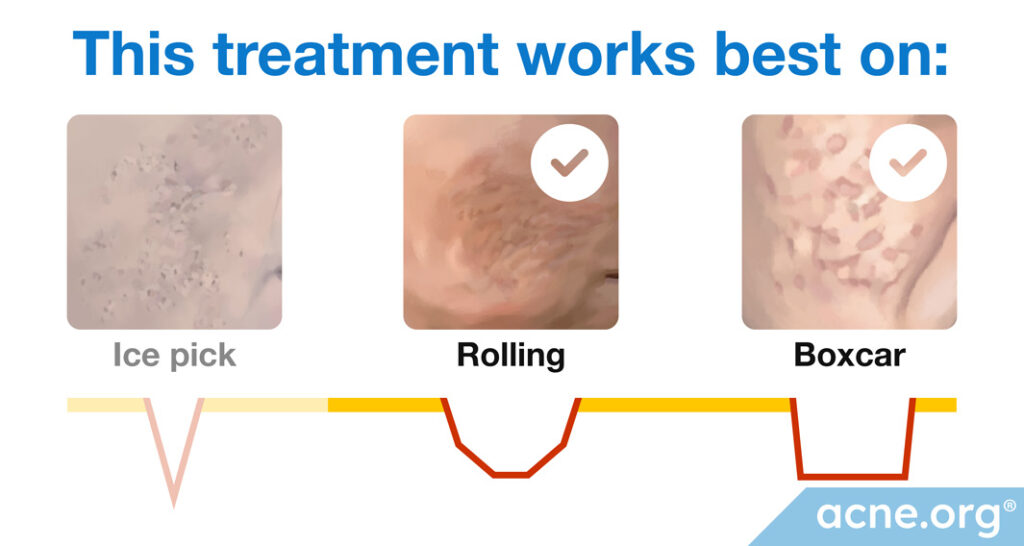
* Dermabrasion works best for boxcar and rolling scars.
Dermabrasion is a painful procedure performed under anesthesia, in which a rough tool is used to essentially rip off the outer layers of the skin. Dermabrasion aims to treat atrophic (indented) acne scars by removing the outer skin layers containing the scars, so that when the skin re-grows, its surface will be smoother and more even. If you decide to undergo dermabrasion, it is paramount to find a very skilled doctor or plastic surgeon who specializes in and has extensive experience specifically with dermabrasion.
Dermabrasion does not work well for hypertrophic (raised) scars and, in a worst-case scenario, could make these types of scars worse.1
While dermabrasion can potentially eliminate boxcar and rolling scars completely, a more realistic outcome is some improvement in the appearance of atrophic scars. In rare cases, dermabrasion does not result in any improvement.2
Dermabrasion has become a less popular scar revision procedure since the introduction of resurfacing lasers. This is because lasers are easier to control and can precisely target a specified depth, whereas dermabrasion relies on a physician to manually control depth, and as we all know, machines can be much more precise than humans. In addition, lasers can target one scar at a time, whereas dermabrasion can only treat large areas of skin.3,4
In addition to acne scars, dermabrasion can also treat a variety of other indented scars, pigmented skin, and other skin problems.
After dermabrasion, while the outer layers of the skin are re-growing, the skin is extremely sensitive to the sun’s rays. Sun exposure during this period can easily burn the skin or lead to post-inflammatory hyperpigmentation (skin darkening) where the procedure was performed. Therefore, it is very important to avoid sun exposure and use sunscreens for 12 weeks after dermabrasion.2,3,5
People with active acne should not undergo acne scar repair of any kind, including dermabrasion. Your skin must be clear of acne before you begin scar treatment.
Doctors recommend waiting at least 6 months after isotretinoin (Accutane®) before undergoing dermabrasion.3
As with all scar revision treatments, dermabrasion is sometimes combined with other scar revision treatments to achieve desired results.
Dermabrasion is often combined with techniques that help skin healing and facilitate rapid resurfacing of the treated skin such as platelet-rich plasma (PRP) treatment or ReCell® technique.
Platelet-rich plasma is a procedure in which a medical professional extracts the patient’s own blood just before the start of the treatment. Then, after putting the blood into a machine to isolate plasma from the blood, the plasma is injected into the skin in order to encourage healing and create a smoother skin surface.
In ReCell® technique is a more invasive procedure in which a skilled medical professional uses a device to remove a 2cm by 2cm piece of skin from behind your ear. This skin is then processed with a ReCell® device, which isolates cells crucial for skin regeneration. These cells are added to a solution to create a suspension. Finally, the doctor massages the prepared cell suspension onto the surface of your skin.8
Before agreeing to undergo dermabrasion, talk to multiple doctors about their opinions, proposed treatments, expected outcomes, and prices.
Procedure details:
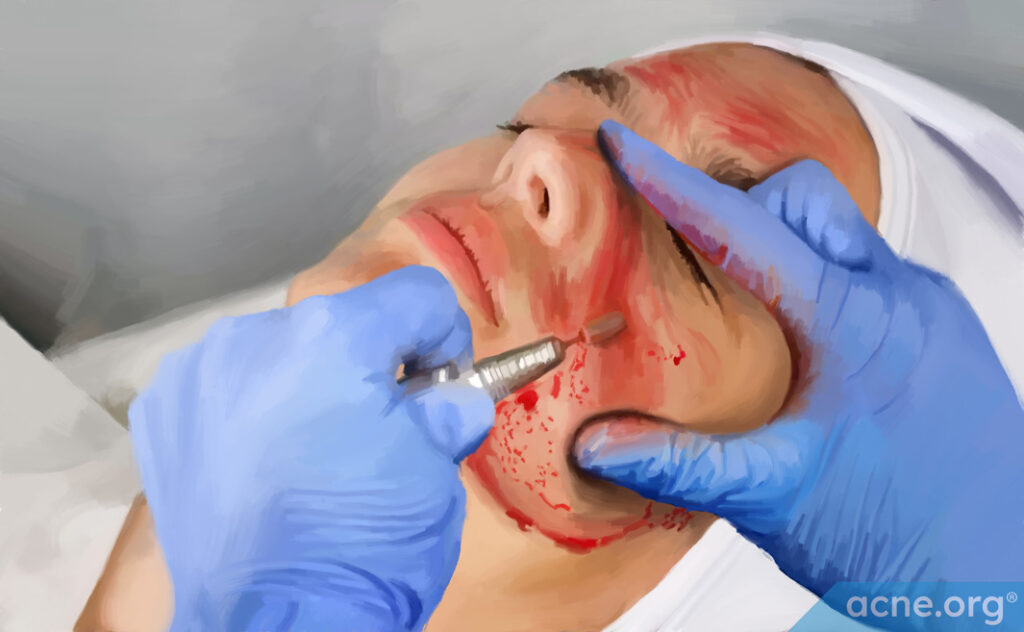
In dermabrasion, the doctor uses a hand-held tool to remove the epidermis (the outer layer of the skin) and, in cases of severe scarring, part of the dermis (the second, deeper layer of the skin) as well.1,2
Types of dermabrasion treatments:
- Superficial treatment: Removes the epidermis only
- Deep treatment: Removes both the epidermis and a part of the dermis
The doctor may use one of the following tools for the procedure:
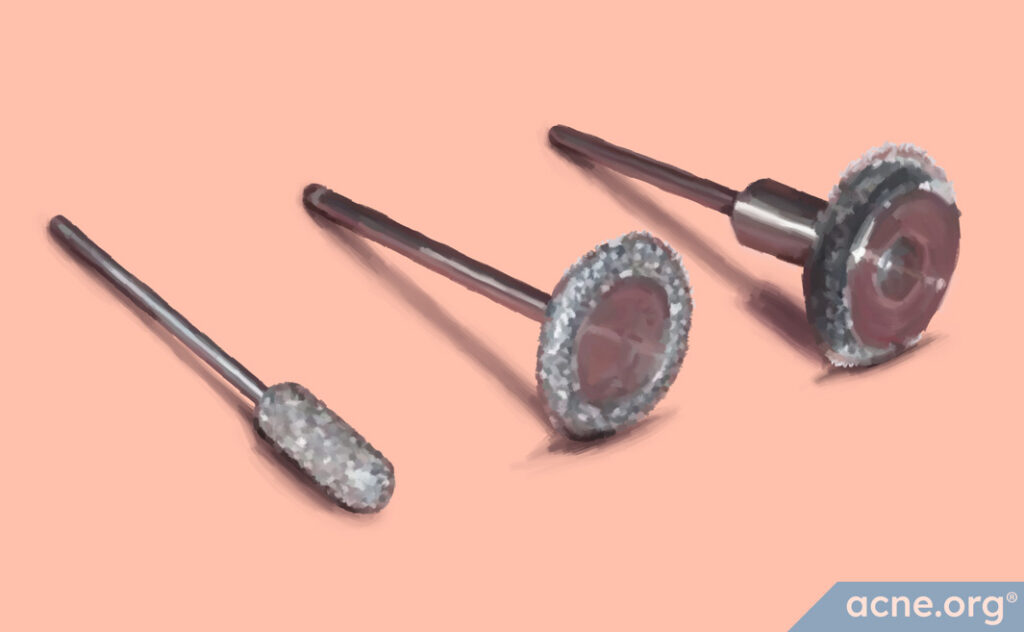
- A hand-held device with a spinning diamond-encrusted wheel or a spinning high-speed brush: The doctor moves the device over the skin with firm, steady strokes and even pressure. Hand-held devices are the more popular type of dermabrasion tools because they are quiet and easy to maneuver.2
- Sterile silicone sandpaper: The doctor uses the sandpaper to manually “sand” the skin the way you would sand wood.1,6
After dermabrasion, the doctor applies wound dressings to the treated skin. The dressings must be changed daily for the first few days after the procedure. The type of dressing the doctor chooses will determine how soon the skin begins to produce a crust formation.7 Generally, crust formation will occur between 5 and 12 days after dermabrasion. The formation of crust marks the start of the healing process when the skin begins to re-epithelialize (grow new skin cells to replace the skin the doctor removed). Once the crust begins to form, dressings are no longer necessary, and the skin can be left open to the air.1,2
Anesthesia:
Dermabrasion is a painful procedure that requires anesthesia. Your doctor will choose one of the following options, or a combination, depending on the size of the treatment area and the patient’s preferences:1,2
- Local anesthesia: The doctor numbs only the skin area that will be treated. Local anesthesia comes in many forms:
- Cryo-anesthesia spray: A cooling spray is applied to the skin, after which the skin becomes very cold and develops a white frost. To increase the anesthetic effect, the doctor may pre-chill the skin by applying ice packs before the spray. It is important for the doctor not to over-freeze the skin, which can lead to deep necrosis (death of skin cells).2
- Topical numbing gel: The doctor applies a gel to the skin surface to numb the area.
- Injection of local anesthetic: An anesthetic is injected to numb the skin area to be treated.
- Light sedation: Medications are administered so that the patient remains awake but does not feel pain or anxiety.
- General anesthesia: An anesthesiologist administers medications that put the patient to sleep for the duration of the procedure.
In most cases, doctors use only local anesthesia or a light sedative and perform dermabrasion in an outpatient operating facility. General anesthesia is not necessary, but if the patient prefers to be asleep during the procedure, the doctor will have to perform dermabrasion in a hospital.
Before-and-after:
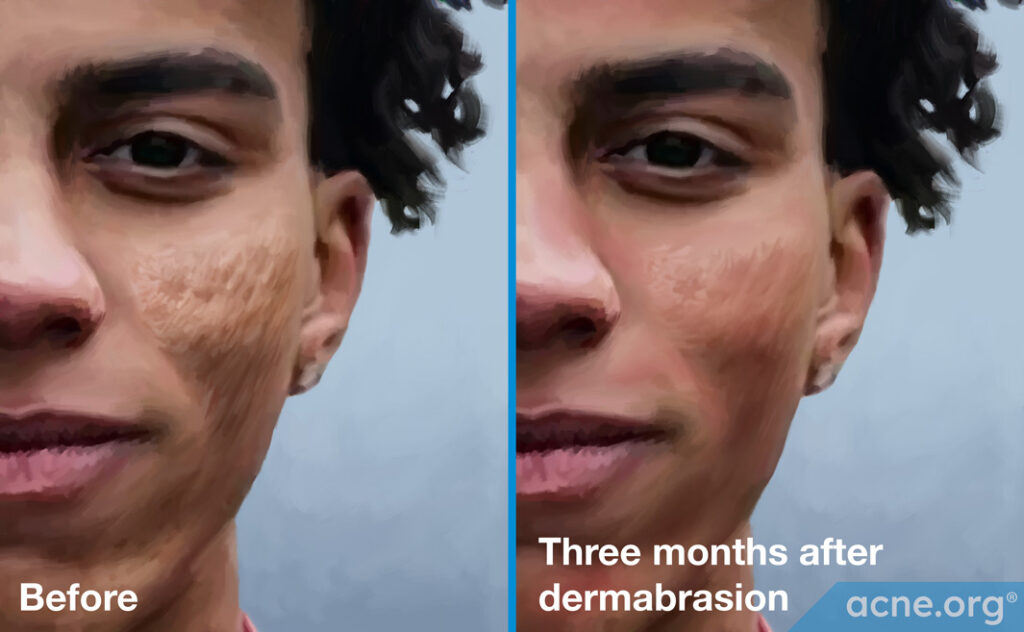
Acne scars before (left) and 3 months after (right) dermabrasion.
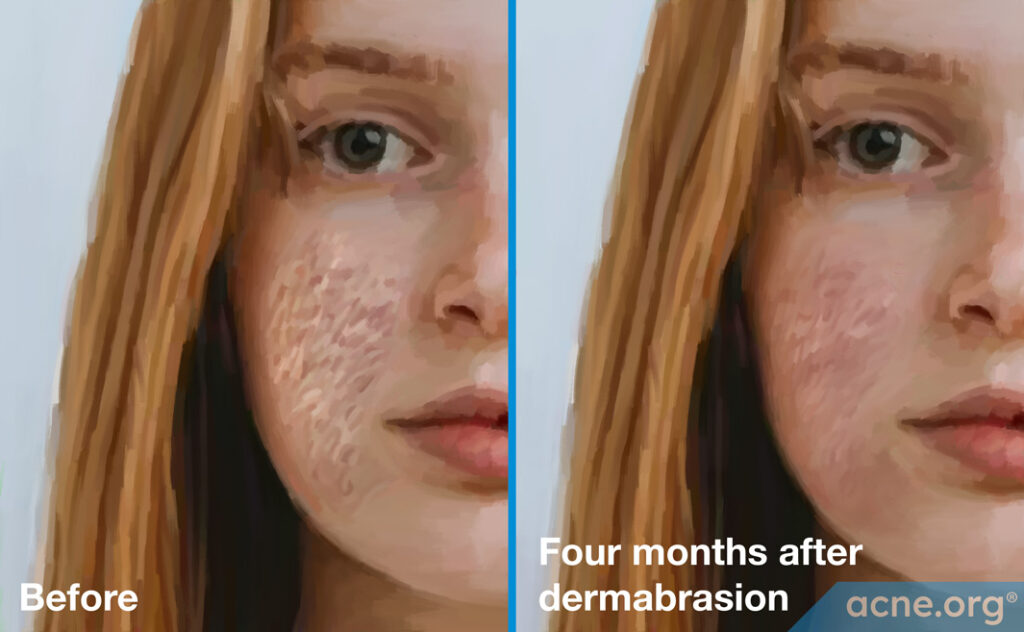
Acne scars before (left) and four months after (right) dermabrasion.
References
- Rivera, AE. Acne scarring: a review and current treatment modalities. J Am Acad Dermatol 59, 659-676 (2008).
- Roenigk, HH. Dermabrasion: state of the art 2002. J Cosmet Dermatol 1, 72-97 (2002).
- Levy LL, and Zeichner JA. Management of acne scarring, part II. A comparative review of non-laser-based, minimally invasive approaches. Am J Clin Dermatol. 13(5), 331-340 (2012).
- Frank W. Therapeutic dermabrasion: back to the future. Arch Dermatol 130(9), 1187-1189 (1994).
- Nelson BR, et al. A comparison of wire brush and diamond fraise superficial dermabrasion for photoaged skin: A clinical, immunohistologic, and biochemical study. Journal of the American Academy of Dermatology 34(2), 235-243 (1996).
- Pavlidis L, and Spyropoulou G.A. A simple technique to perform manual dermabrasion with sandpaper. Dermatol Surgery 38(12), 2016-2017 (2012).
- Hom DB, Harmon J. Dermabrasion for Scars and Wire Loop Electrocautery for Rhinophyma. Facial Plast Surg. 35(3), 267-73 (2019).
- Chen Q, Yu N, Liu Z, Zhang W, Long F, Zeng A, Zhu L, Wang X. The Clinical Efficacy of ReCell® Autologous Cell Regeneration Techniques Combined with Dermabrasion Treatment in Acne Scars. Aesthetic Plast Surg. 44(2), 535-42 (2020).
Future reading
- Aronsson A, Eriksson T, Jacobsson S, and Salemark L. Effects of dermabrasion on acne scarring. A review and a study of 25 cases. Acta Derm Venereol. 77(1), 39-42 (1997).
- Maddin S, Danto JL, and Steward WD. Dermal abrasion for the removal of acne scars. Can Med Assoc J. 82, 1072-4 (1960).
 Acne.org Products
Acne.org Products